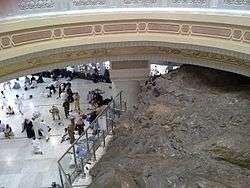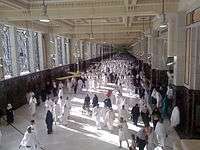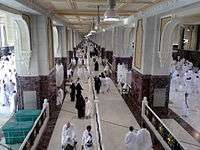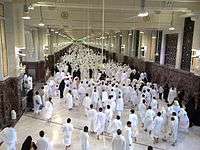Al-Safa and Al-Marwah

| Part of a series on |
| Islam |
|---|
 |
|
Related topics |
|
Al-Safa and Al-Marwah (Safa and Marwah) (Arabic: الصفا Aṣ-Ṣafā, المروة al-Marwah) are two small hills now located in the Masjid al-Haram in Mecca, Saudi Arabia between which Muslims travel back and forth seven times during the ritual pilgrimages of Hajj and Umrah.
History
In Islamic tradition, Ibrahim (Abraham) was commanded by God to leave his wife Hajar (Hagar) and their infant son alone in the desert between Al-Safa and Al-Marwah. When their provisions were exhausted, Hagar went in search of help or water. To make her search easier and faster, she went alone, leaving the infant Ismail (Ishmael) on the ground.
She first climbed the nearest hill, Al-Safa, to look over the surrounding area. When she saw nothing, she then went to the other hill, Al-Marwah, to look around. While Hagar was on either hillside, she was able to see Ismael and know he was safe. However, when she was in the valley between the hills she was unable to see her son, and would thus run whilst in the valley and walk at a normal pace when on the hillsides. Hagar travelled back and forth between the hills seven times in the scorching heat before returning to her son. When she arrived, she found that a spring had broken forth from where the Angel Jibreel hit the ground with his wing. This spring is now known as the Zamzam Well, and was revealed by the angel of God as both sustenance and a reward for Hagar's patience.
Location
The Masjid al-Haram houses the Kaaba, the focal point of prayer for all Muslims. Safa — from which the ritual walking (Arabic: سعى saʿy) begins — is located approximately 100 m (330 ft) from the Kaaba. Marwah is located about 350 m (1,150 ft) from the Kaaba. The distance between Safa and Marwah is approximately 450 m (1,480 ft), so that seven trips amount to roughly 3.15 km (1.96 mi). The two points and the path between them are now inside a long gallery that forms part of the Masjid.
The Sa'i
Performing the Sa'i, also known as Sa'ee[1] (Arabic: سعى saʿy "seeking" or "search"), serves to commemorate Hagar's search for water and God's mercy in answering prayers.
| Wikimedia Commons has media related to Sa'yee. |
-

Sa'yee towards Al-Safa
-

Central section reserved for the elderly and disabled.
Note that it is also divided into two directions of travel. -

Sa'yee returning from Al-Safa
In the Qur'an
Al-Safa and Al-Marwah are also mentioned in the Qur'an.
Behold! Safa and Marwa are among the Symbols of Allah. So if those who visit the House in the Season or at other times, should compass them round, it is no sin in them. And if any one obeyeth his own impulse to good,- be sure that Allah is He Who recogniseth and knoweth.
In Western culture
Mount Safa is allegedly the mountain referred to in the European proverb "If the mountain will not come to Mohammed, Mohammed must go to the mountain",[3] sometimes incorrectly quoted the opposite way around. English language sources trace the first written English use of the saying to Francis Bacon.[4]
References
Coordinates: 21°25′25″N 39°49′38″E / 21.42361°N 39.82722°E
